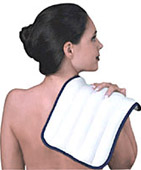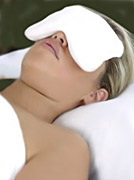In modern times, water treatments was popularised by many European water-cure pioneers. They raised water cure to an institutional level and employed it successfully for the treatments of almost every known disease. Beneficial effects are exeted by water on the human system. It equalises circulation, boosts muscular tone and aids digestion and nutrition. It also tones up the activity of perspiratory gland and in the process eliminates the damaged cells and toxic matter from the system. Hence, in recent times, there are numerous spas in most all countries where water treatment is used as a major healing agent. The common water temperature chart used for water therapy is as follows:
Cold: 10 degree C to 18 degree CNeutral: 32 degree C to 36 degree C and
Hot: 40 degree C to 45 degree C.
It should be noted that above 45 degree C, water loses its therapeutic value and is destructive. Let us discuss the usage of water in various therapeutic treatments.
 1. Cold Compress: This is a local application using a cloth, which has been wrung out in cold water; One just has to place essential aroma oils in 100 mI. cold water with six ice cubes in a bowl and use the cold compress. The cloth should be folded into a broad strip and dipped in cold water or ice water. Cold Compresses are used for headaches, sprains, inflammation, fever, swollen bumps, burns, blisters, sore feet, rashes, measles, chicken pox, sunburn or a hangover.
1. Cold Compress: This is a local application using a cloth, which has been wrung out in cold water; One just has to place essential aroma oils in 100 mI. cold water with six ice cubes in a bowl and use the cold compress. The cloth should be folded into a broad strip and dipped in cold water or ice water. Cold Compresses are used for headaches, sprains, inflammation, fever, swollen bumps, burns, blisters, sore feet, rashes, measles, chicken pox, sunburn or a hangover.2. Enema: An enema involves the injection of fluid into the rectum and is also known as rectal irrigation, where only lukewarm water is used for cleaning the bowels, since it not only the safest system for cleaning the bowels, but also improves the peristalic movement of the bowels and thereby relieves constipation. In this form of nature cure treatment, the patient is made to lie on his left side extending his left leg and bending the right leg slightly. The enema nozzle, lubricated with oil or Vaseline, is inserted in the rectum. The enema can, containing the lukewarm water is then slowly raised and water is allowed to enter into the rectum. Generally, one to two litre of water is injected. The patient may either lie down on his back or walk a little while retaining the water. After five to 10 minutes, the water can be ejected along with the accumulated morbid matter.
 3. Heating Compress: This is a cold compress covered in such a manner as to bring warmth. It consists of three or four folds of linen cloth wrung out in cold water, which is then covered completely with dry flannel or blanket to prevent the circulation of air and help accumulation of body heat. The duration of the application is determined by the extent and location of the surface involved, the nature and thickness of the coverings and the water temperature; it is sometimes applied for several hours. The area should be rubbed with a wet cloth after removing the compress and then dried with a towel. A heating compress can be applied to the following organs of the body:
3. Heating Compress: This is a cold compress covered in such a manner as to bring warmth. It consists of three or four folds of linen cloth wrung out in cold water, which is then covered completely with dry flannel or blanket to prevent the circulation of air and help accumulation of body heat. The duration of the application is determined by the extent and location of the surface involved, the nature and thickness of the coverings and the water temperature; it is sometimes applied for several hours. The area should be rubbed with a wet cloth after removing the compress and then dried with a towel. A heating compress can be applied to the following organs of the body:i. Throat Compress: It relieves sore throat, hoarseness, tonsillitis, pharyngitis and laryngitis.
ii. Chest Compress: Also known as chest pack; relieves cold, bronchitis, pleurisy, pneumonia, fever and cough.
iii. Abdomen Compress: It helps those suffering from gastritis, hyperacidity, , jaundice, constipation, diarrhoea, dysentery and other ailments relating to the abdominal organs.
iv. Joints Compress: It is helpful for inflamed joints, rheumatism, rheumatic fever and sprains.
For more, visit the link below: